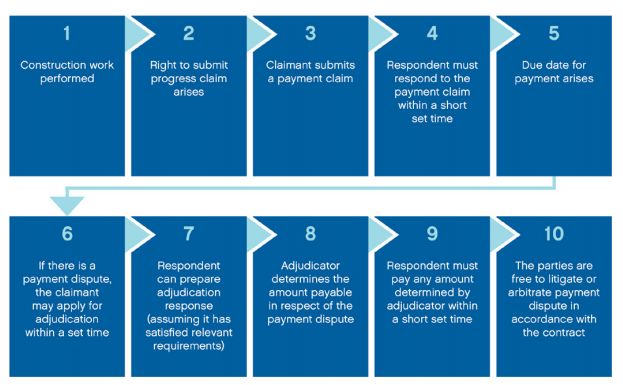AUSTRALIA: A SNAPSHOT
Security-of-payment legislation has been enacted in every Australian jurisdiction, providing a statutory regime for the submission and payment of regular progress claims and the resolution of any payment disputes in relation to construction work that falls within the ambit of the relevant legislation. Each of the regimes grant rights to submit progress claims and to have any dispute in respect of those claims resolved more quickly, on an interim basis, by a process of statutory adjudication governed by specific rules and short timeframes. In broad terms, each regime generally involves the following:

The overall time it takes to have a disputed payment claim determined by adjudication varies in each jurisdiction, but it can be as short as approximately 35 business days (in New South Wales ("NSW") and South Australia ("SA")—so the process is a fast one, presenting both opportunities and challenges for those involved. The adjudicator's decision is binding on the parties unless and until a party seeks relief from a court to set aside the adjudicator's award (which is generally available only in limited circumstances) or as part of an action to finally determine the rights between the parties on the matters the subject of the adjudication. The process provides a quicker, "interim" resolution procedure, without prejudicing the parties' final rights if disputes remain.
Although there are similarities between jurisdictions, there are also important differences in the procedural steps, requirements and timeframes that apply, and non-compliance can have significant consequences. Keeping up to date on the differences is of particular importance given that many major industry participants operate on a national basis.
There have long been calls for harmonization of securityof-payment legislation across Australia, and there have been a number of formal reviews recommending how this should be achieved. This includes the national review undertaken by John Murray in December 2017 ("Murray Review")1 and the review undertaken by John Fiocco in October 2018 ("Fiocco Review"),2 both of which are influencing legislative developments. The desire for a consistent national securityof-payment regime has contributed to recent reforms being proposed in some Australian jurisdictions, with a particular focus on bringing the "West Coast Model" into line with the "East Coast Model". Western Australia recently proposed significant reform to its security-of-payment regime (for more information, see our recent White Paper on proposed reform to Western Australia's security-of-payment regime3 ), reforms on a similar scale have been proposed in Queensland and a number of changes to the NSW regime commenced not all that long ago, in October 2019.
This White Paper provides an overview of the current status of security-of-payment legislation in each Australian State and Territory, along with a snapshot of recent legislative developments and trends in case law. Across all Australian jurisdictions, a continuing theme seen in the cases regarding adjudication is the tension between upholding strict procedural requirements on the one hand and protecting substantively meritorious claims on the other.
Given the differences in the security-of-payment regimes across the country, we have also included a quick reference guide in the form of two comparison tables. The tables highlight key differences between each State and Territory's security-of-payment regime and adjudication process—such as the timeframes involved for payment claims and responses, and the types of work that may be claimed in a payment claim or adjudication application brought under the local legislation.
To see the full article click here.
The content of this article is intended to provide a general guide to the subject matter. Specialist advice should be sought about your specific circumstances.





